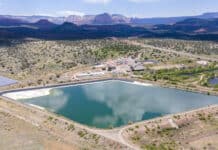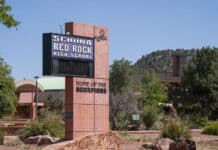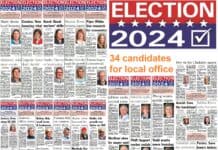Getting everyone on the same page — or at least in the same book — was the goal of a first-ever meeting of the minds between the Sedona City Council and the Sedona Chamber of Commerce Board of Directors.
The four-hour meeting took place on Jan. 17, with a round table discussion with nearly 20 members of the council and board present.
In order to adequately address these items moving forward council requested that, for the new contract period, a joint work session take place annually between the council and the chamber prior to development of the upcoming year’s program of work, budget and marketing plans, a city report states.
The purpose of the meeting was to provide an opportunity for the council and chamber board to engage in dialogue regarding current year goals and objectives, assess the state of the tourism industry, respond to changing needs, identify priorities and develop a coordinated tourism approach for the upcoming year.
The report added that the chamber will still be required to bring back a fully developed program of work for destination marketing and visitor services, a product development plan and a proposed budget for council approval prior to July 1 for the fiscal year 2018-19 contract period.
In addition, council requested the following take place:
- Structure the contract to promote more active involvement from the council in annual decisions related to desired outcomes and policy level objectives relating to the program of work, marketing approach and product development programs and projects.
- Develop a more sustainable tourism approach that considers and addresses the need to better balance the interests of residents and tourists, and to mitigate the unintended consequences of such a robust tourist economy.
“The council expressed a desire to play a more active role in the annual decision-making process while setting the policy direction around how the strategies and tactics for tourism promotion are pursued,” Assistant City Manager Karen Osburn said. “As a result, we wrote into the contract that an annual work session would be held. We’re hoping this will create this really focused opportunity to collaboratively discuss the state of tourism in Sedona in terms of what’s working and what’s not and what the overarching goals are for the upcoming year.”
Chamber President and CEO Jennifer Wesselhoff led the meeting and said she wanted to discuss the upcoming year, whether or not they pressed the brakes too hard with reduced marketing in the Phoenix area last year and what is the sweet spot in balancing tourism and quality of life for residents.
She said the chamber finished the previous fiscal year [which ended June 30] on a high note as sales taxes were up 9 percent over the previous year and the bed tax jumped by 28 percent, of which 55 percent goes to the chamber. But over the first three months of this fiscal year, the numbers have dropped. Through September, the sales tax is up
4 percent and bed tax at 9 percent. She said the drop, compared to last year, was due to the bump in tourism from the National Park Service’s 100th anniversary in 2016, road construction above the overlook in Oak Creek Canyon, worse weather this summer than last and the 15 percent reduction in marketing to Phoenix residents.
“We’re still continuing to see climbs in sales and bed taxes, but we’ve started to see a couple of dips,” she said, noting that average daily rate in the hotels is up 16 percent from 2014. “Overall I think we’re still trending well, but we do have some concerns when we start to look at our other performance indicators, which aren’t as quantifiable as the money in your pockets from sales and bed taxes as it relates to occupancy.”
As they have in the past, the chamber reduces its marketing for the busy times of the year — spring and fall — and focuses on summer and winter when visitor numbers are down. When doing so, it’s a matter of quality over quantity as the hoteliers would rather see fewer people at a higher daily rate than vice versa.
“We’ve been trying to attract that quality visitor over simply going for more, more, more, more, more,” Wesselhoff said. “We’re not trying to attract more people, but it’s a matter of attracting people who want to pay higher rates and contribute more to our economy.”
She said the chamber’s long-term goals include to attract, manage and monitor tourism for the benefit of residents, industry and visitors; to make visiting Sedona a positive and seamless process and to sustain a reasonable balance between tourism and the quality of life in Sedona. Councilman Jon Thompson said he would like to have sustainability added to that list of goals.
Later, Sedona Lodging Council President Steve Segner spoke and discussed how the chamber dollars are spent marketing to other cities, states and countries. He said that right now, things are going well for most hoteliers, and that they can’t focus on the negative.
“It’s true, summers are hard,” he said. “We’re full on weekends. What we need are more mid-week visitors and more winter business. We had a very good December. We’re on the right track, but let’s not try and micromanage.
“Maricopa County is the fastest growing county in America. Let’s welcome these people, and let’s not use day-trippers as a bad word because Uptown lives off those people. We’ve got a good thing going. Let’s try not to get too negative.”
Other topics discussed were better promotion and coordination of local events, stable occupancy throughout the year, how to attract business conferences, sustainability, transportation and elevating of arts and wellness.
One topic near the end of the meeting that drew a lot of discussion was how much of the chamber’s funding from the city should go toward marketing and advertising as opposed to product development. Also, the role council has in determining how that funding is spent and whether it should be in more general or specific terms.
“The purpose of this meeting was really to help give us direction so we’re all working on the same priorities and that we’re all on the same page in terms of our strategy,” Wesselhoff said. “It’s then our job to work with our board and to go through our whole planning process, which reaches out to hundreds of stakeholders including a survey to all of our business partners. It then goes back to our board. They’re the fiscal agents of our organization. We are contracted by you, but you’re not our fiscal agent. It’s then the responsibility of our board to come back to you with a budget you can approve based on the overarching priorities, strategy and goals.”
Ron Eland can be reached at 282-7795 ext. 122 or by email at reland@larsonnewspapers.com

















